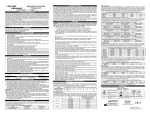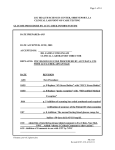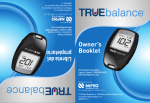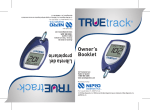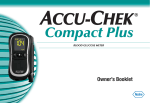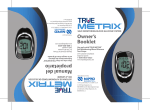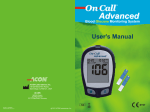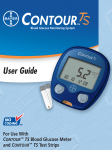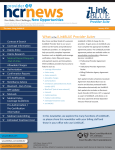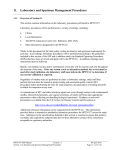Download Owner`s Booklet - Nipro Diagnostics
Transcript
© 2014 Nipro Diagnostics, Inc. TRUE2go, TRUEtest, TRUEresult y el logotipo de Nipro Diagnostics son marcas comerciales de Nipro Diagnostics, Inc. F4NPD03 Rev. 24 Fort Lauderdale, FL 33309 EE. UU. Fabricado por: Usar solo con tiras de prueba de glucosa en la sangre TRUEtest™ Owner’s Booklet Atención al Cliente las 24 horas, 7 días a la semana Inglés o español 1-800-803-6025 1-954-677-4599 www.niprodiagnostics.com 24/7 Customer Consultation English or Spanish 1-800-803-6025 1-954-677-4599 www.niprodiagnostics.com Libreta del propietario Use only with TRUEtest™ Blood Glucose Test Strips Manufactured by: © 2014 Nipro Diagnostics, Inc. TRUE2go, TRUEtest, TRUEresult and the Nipro Diagnostics logo are trademarks of Nipro Diagnostics, Inc. F4NPD03 Rev. 24 Scan this code with your smart phone for additional TRUE2go information. Always refer to the Owner’s Booklet for detailed product information. Guía de prueba rápida Dos pasos simples INSERTE LA TIRA DE PRUEBA 2 APLIQUE LA MUESTRA DE SANGRE 2 APPLY BLOOD SAMPLE Solo para referencia rápida; no se pretende que sea un sustituto del instructivo completo. Lea toda la Libreta del propietario y las Instrucciones para el uso del producto antes de realizar pruebas. INSERT TEST STRIP 1 Expected Results for people without diabetes: Plasma Blood Glucose Result1 Before eating < 100 mg/dL For quick reference only, not intended as a substitute for complete instructions. Please read entire Owner’s Booklet and product Instructions for Use before testing. 1 Twosimple steps Fast Test Guide Resultados esperados para personas sin diabetes: Resultado de glucosa en plasma/sangre1 < 100 mg/dl Antes de comer INTRODUCTION: TRUE2go™ Blood Glucose Monitoring System TRUE2go is a simple, accurate way to test whole blood glucose (sugar) level, anytime, anywhere. Our goal is to provide quality healthcare products and dedicated customer service. For questions about TRUE2go products, visit our web site at: www.niprodiagnostics.com. Caution! Please read complete Owner’s Booklet and all product Instructions for Use. Additional instructions for use of the System in a professional multi-patient setting are included in the Quality Assurance/Quality Control Manual. The QA/QC Manual is available on our website www.niprodiagnostics.com, or call 1-800-803-6025 or 1-954-677-4599. Importance of Blood Glucose Monitoring The more you know about diabetes, the better you will be able to care for yourself. A Doctor or Diabetes Healthcare Professional will determine how often you should test and what your target ranges are for blood glucose results. Having most results within your target ranges shows how well a treatment plan is working to control glucose levels. Keeping results within your target ranges helps slow or stop complications from diabetes. NEVER change your treatment plan without consulting a Doctor or Diabetes Healthcare Professional. Use of TRUE2go in a manner not specified in this Owner’s Booklet is not recommended and may affect the ability to determine true blood glucose levels. 1 FOR PATIENTS IMPORTANT HEALTH and SAFETY INFORMATION: WARNING! NEVER reuse Test Strips. NEVER wipe Test Strips with water, alcohol or any cleaner. DO NOT attempt to remove blood or control sample from Test Strips or clean Test Strips and re-use. Reuse of Test Strips will cause inaccurate results. • NEVER add a second drop of sample to Strip. Adding more sample gives an error message. The TRUE2go Blood Glucose Monitoring System is for one person use ONLY. DO NOT share your Meter or your Lancing Device with anyone, including family members. DO NOT use on more than one person. ALL parts of your Blood Glucose Monitoring System could carry blood-borne diseases after use, even after cleaning and disinfection.2,3 For cleaning and disinfecting your Meter see Meter Care, Cleaning/Disinfection. For cleaning and disinfecting your Lancing Device see the Instructions for Use. Caution! We suggest cleaning the Meter when visibly dirty. Wash your hands thoroughly with soap and warm water after handling the Meter, Lancing Device, or Test Strips as contact with blood presents an infection risk. 2 FOR PATIENTS IMPORTANT HEALTH and SAFETY INFORMATION: • DO NOT use the TRUE2go System to test your blood glucose if you are undergoing peritoneal dialysis (dialysis through the abdomen/stomach area). • DO NOT use the TRUE2go System to test your blood glucose if you are receiving medical treatment that contains sugars such as maltose or xylose (Extraneal®, Icodial®, immunoglobulins such as Octagam®, or Orencia®). The treatments listed above may cause false high glucose results when testing with the TRUE2go System.4 Before using the TRUE2go System, check with your Doctor or Healthcare Professional if you think you may be receiving any of these treatments. If you have symptoms of low or high blood glucose, check your blood glucose immediately. If your result does not match the way you feel, repeat the test. If your results still do not match the way you feel, call your Doctor or Healthcare Professional. • Low blood glucose (hypoglycemia) symptoms may be trembling, sweating, intense hunger, nervousness, weakness, and trouble speaking. • High blood glucose (hyperglycemia) symptoms may be intense thirst, a need to urinate often, a dry mouth, vomiting, and headache. 3 FOR HEALTHCARE PROFESSIONALS IMPORTANT HEALTH AND SAFETY INFORMATION: DO NOT use the TRUE2go System for patients receiving the following treatments: •Peritoneal dialysis using solutions containing icodextrin (Extraneal®, Icodial®) that is metabolized to maltose, •Injections or infusions of solutions containing galactose or maltose, including some human immunoglobulin preparations (Octagam®, WinRho®, SDF Liquid, HepaGam B™), •Xylose absorption testing, •Intravenous solutions containing maltose, •Any drugs that contain or metabolize to maltose, galactose, or xylose (Orencia®, Adept®, Bexxar®). Using the TRUE2go System when receiving the above treatments may cause false high glucose results.4 False high results may lead to inappropriate therapy, which may result in coma or death. For more information see www.fda.gov/BiologicsBloodVaccines/ SafetyAvailability/ucm154213.htm . Additional instructions for use of the System in a professional multi-patient setting are included in the Quality Assurance/Quality Control Manual. The QA/QC Manual is available on our website www.niprodiagnostics.com, or call 1-800-803-6025 or 1-954-677-4599. 4 Safe Practices Recommendations for Healthcare Professionals: • At patient admission/presentation and periodically throughout the patient’s stay at the facility, assess the presence and use of therapies containing interfering drugs (see previous page). • Use only laboratory methods for monitoring blood glucose levels in patients receiving interfering drugs. • If there are pre-print order sets for patients receiving interfering drugs, include a prescription to test blood glucose using only laboratory methods. • Establish facility protocols to verify point-of-care (bedside) blood glucose results with laboratory results for patients who are unresponsive or unable to communicate. 5 Other Important Information for Healthcare Professionals The most accurate results come from using fresh, capillary whole blood from the fingertip or forearm. Venous whole blood drawn into EDTA (purple top tube) or heparin (green top tube) may be used. Mix tube contents gently before using. When comparing results between TRUE2go and a laboratory system, perform a TRUE2go blood test within 30 minutes of laboratory test. Results from TRUE2go are considered accurate if within 20% of laboratory results.5 If patient has recently eaten, fingerstick results from TRUE2go can be up to 70 mg/dL higher than venous laboratory results.6 DO NOT perform capillary blood glucose testing on critically ill patients. Capillary blood glucose levels in critically ill patients with reduced peripheral blood flow may not reflect the true physiological state. Reduced peripheral blood flow may result from the following conditions (for example):7 •shock • severe hypotension • severe dehydration • hyperglycemia with hyperosmolarity, with or without ketosis. 6 IMPORTANT INFORMATION: For the most accurate results using TRUE2go: • Read all instructions before testing. • TRUE2go is an in vitro (outside body) quantitative system that is used for self-testing and point-of-care testing of human whole blood only. • Meter displays results as plasma values. • Use only TRUEtest™ Test Strips and TRUEtest Glucose Control with TRUE2go Meter. • Do not use for diagnosis of diabetes or for testing blood glucose in newborns. • Perform Control Tests before performing a blood glucose test for the first time (see Getting Started). Note: Three levels of TRUEtest Glucose Control Solution are available for Quality Control Testing. It is important to perform Control Tests with more than one level of Control to assure your System is working properly and your testing technique is good. Contact place of purchase or call for assistance to obtain Control. • When carrying your TRUE2go System with you, do not leave it where the storage temperature printed on vial label may be exceeded (car, trunk, briefcase, etc). • Remove only one Strip at a time from vial when testing. Recap vial immediately after removing Strip. • When using the meter for the first time, check the unit of measure in the meter Display after performing a control or blood test. Result must display in the correct unit of measure (mg/dL). • If the result does not display in the correct unit of measure, DO NOT use the meter and DO NOT use the meter result to determine treatment. 7 Phone Number, Fast Test Guide, Expected Results..................... ............................................................................................see covers Introduction and Important Information............................... 1-7 Table of Contents........................................................................... 8 Know Your System Meter............................................................................................. 9 Test Strip ...................................................................................10 Test Strip Vial Label.................................................................11 Glucose Control Bottle Label..................................................12 Attach/Remove TRUE2go Meter to Test Strip Vial............13 Getting Started Quality Control................................................................... 14-15 Control Test......................................................................... 16-19 Testing your Blood Obtaining a Blood Sample................................................. 20-21 Testing Blood Glucose........................................................ 22-23 System Out of Range Warning Messages..............................24 Meter Memory Viewing Results in Memory....................................................25 Care, Cleaning/Disinfection and Troubleshooting Caring for TRUE2go........................................................... 26-27 Changing Battery................................................................. 28-29 Troubleshooting........................................................................30 Display Messages............................................................. 31-32 System Specifications/Chemical Composition.........................33 Meter Warranty.............................................................................34 References.......................................................................................35 8 Know Your System Meter Top of Meter Bottom of Meter 1 7 2 3 4 5 8 6 ①Set Button - Turn Meter on for Memory, view/ scroll results in Memory, mark result as Alternate Site. ②Display - Shows results, messages, user prompts, information. ③Drop Symbol - Apply blood or Glucose Control. ④Units of Measure - Note: Factory set, cannot be changed by user. ⑤Strip Release Button - Releases Strip after testing. ⑥Test Port - Insert TRUEtest Test Strip here. ⑦Meter Label - Contains serial number of Meter and phone number to call for assistance. ⑧Battery Cover - Use one non-rechargeable 3V lithium battery (#CR2032), positive (“+”) side up (See Changing Battery). 9 Test Strip Top of Test Strip 2 1 ① Contact End - Insert into Test Port with blocks (contacts) facing up. ② Sample Tip - Bring sample (fresh, capillary or venous blood or Glucose Control) to edge of Tip. Note: Insert Strip into Meter before touching Sample Tip to blood or Control drop. Sample Placement Correct Placement Incorrect Placement • Allow sample (blood or Glucose Control drop) to be drawn into Sample Tip until testing begins (Dashes move across Display). • Do not smear or scrape drop with Strip. • Do not apply more sample to the Strip after testing begins. Note: Do not apply blood or Glucose Control to top of Test Strip. Do not insert Sample Tip with sample into Meter for testing. May damage Meter. 10 Test Strip Vial Label 1 2 3 2 May 30, 2014 ①Lot Number (LOT) - Used for identification when calling for assistance. ②Expiration Dates (EXP) - Write date first opened on vial label. Discard vial and unused Strips if either 4 months after opening or date printed next to EXP on vial label has passed, whichever comes first. Caution! Use of Test Strips or Glucose Control past the Expiration Dates may give incorrect test results. Discard out-of-date products and test with new products. ③Control Range - Range of numbers in which Control Test result must fall to assure System is working properly. 11 May 30, 2014 Glucose Control Bottle Label 3 1 2 ①Lot Number (LOT) - Used for identification when calling for assistance. ②Expiration Dates (EXP) - Write date first opened on bottle label. Discard bottle if either 3 months after opening or date printed next to EXP on bottle label has passed, whichever comes first. ③Control Level (1, 2, or 3) - Three levels of TRUEtest Control are available. We recommend testing at least 2 levels of Control. Use the number on the front cover for information on how to obtain different levels of Control. 12 To Attach / Remove TRUE2go Meter to TRUEtest Test Strip Vial The TRUE2go Meter is made to attach to the top of the Test TRUEtest Test Strip vial cap. Port To attach: Vial Lip 1.Set Test Strip vial on flat surface with vial lip facing front. 2.With Test Port facing right, place bottom of Meter firmly on vial top. Meter must be seated flat on top of vial cap. 3.Holding the vial, twist the Meter 1/4 turn clockwise. The Test Port area on the Meter should cover the vial lip if attached properly. Lift Up To Open 4.To open the vial, lift up on the Meter under the Test Port. To remove: 1. Holding the vial, twist the Meter 1/4 turn counterclockwise. 2. Lift off Meter from vial top. The Meter may also be used for testing without attaching to the vial. 13 Getting Started The Meter turns on when a Test Strip is inserted into the Test Port or when Set Button is pressed (see Memory). Meter turns off when the Strip is released or after 2 minutes of non-use. 14 Quality Control Testing To assure you are getting accurate and reliable results, TRUE2go offers two kinds of quality control tests. These tests let you know that your TRUE2go System is working properly and your testing technique is good. Automatic Self-Test An Automatic Self-Test is performed by the Meter each time a TRUEtest Test Strip is inserted correctly into the Test Port. Insert a Strip into the Test Port. The Meter is working properly if: - the full Display appears, then - the Drop Symbol begins to blink. If an error message appears in the Display, the Meter will not perform a test. See Troubleshooting or call for assistance (see cover for phone number). Full Display Drop Symbol Caution! If any segments are missing in the Display when Meter is first turned on, do not use the Meter for testing. Call for assistance. 15 Control Test We recommend performing Control Tests for practice before using your Meter for the first time to test your blood. Control Tests should be performed: • For practice to ensure your testing technique is good, • Occasionally as you use the vial of Strips, • When opening a new vial of Strips, • If results seem unusually high or low, • If a vial has been left opened or exposed to extreme heat or cold, or humidity, • If Meter damage is suspected (Meter was dropped, crushed, wet, etc.) Note: Three levels of TRUEtest Glucose Control Solution are available for Quality Control Testing. It is important to perform Control Tests with more than one level of Control to assure your System is working properly and your testing technique is good. Contact place of purchase or call for assistance to obtain Control. Caution! Ranges printed on Strip vial label are for Control Test results only and are not suggested levels for your blood glucose. Do not drink Glucose Control. 16 How to Test Glucose Control Use ONLY TRUEtest Glucose Control Solution with the TRUE2go. 1. Allow Control, vial of Strips and Meter to adjust to 68-77ºF (room temperature). Write date first opened on Control bottle label and Strip vial label. Note: Running a Control Test at temperatures outside the range listed above may cause Control to read as a blood test. 2. Check dates on Control label and Strip vial label. Do not use Control or Strips if May 30, 2014 Expiration Dates have passed (Control - 3 Press Down months after opening or date next to EXP To Close on label, whichever comes first; Strips - 4 months after opening or date next to EXP on label, whichever comes first). 3. Swirl or invert bottle gently to mix Control. DO NOT SHAKE! Lift Up To Open 4. Open vial by pushing up under the Test Port of the Meter. Remove one Strip from vial. Close vial immediately by firmly pressing down on the top of the Meter. Note: Use Strip quickly after removal from vial. 5. Insert Strip into Test Port. Meter turns on. Note: If Strip has been out of the vial too long before testing, an error message appears upon insertion of the Strip into the Meter. Release and discard Contacts face up old Strip. Use new Strip for testing. 17 Drop Symbol 0 09 001 LB NE 20 U 9J 6. Wait until Drop Symbol appears in Display. Keep Strip in Meter until testing is finished. Note: If Strip is removed before testing is finished, an error message appears. Release and discard old Strip. Use new Strip for testing. 7. Turn Control bottle upside down. Squeeze one drop of Control onto a clean tissue. Wipe off bottle tip. 8. Gently squeeze a Control drop onto a small piece of unused aluminum foil or clear plastic wrap. Dispose after use. 9. With Strip still in Meter, touch edge of Sample Tip to drop of Control. Allow drop to be drawn into Strip. 10.Remove Strip from drop. Dashes appear across the Display to show Meter is testing. Note: If Meter does not begin testing soon after drawing up sample, release and discard Strip. Repeat test with new Strip. If problem persists, see Troubleshooting. 18 Meter Testing 11. Compare result to Control Range printed on Strip vial label for Control Level you are using. Glucose Control Bottle Label If result is in range, System can be used for testing blood. If result does not fall within range, repeat test using a new Strip. Test Strip Vial Label Note: When using the meter for the first time, check the unit of measure in the meter Display after performing a control or blood test. Result must display in the correct unit of measure (mg/dL). If the result does not display in the correct unit of measure, DO NOT use the meter and DO NOT use the meter result to determine treatment. Caution! If Control Test result is outside range, test again. If result is still outside range, System should not be used for testing blood. Call for assistance (see cover for phone number). 12. After result is shown, turn Meter so that the Strip is pointing down. Press Strip Release button to release and discard Strip in appropriate container. Meter turns off. Note: Removing Strip before result displays cancels the test. An error message appears and the result is not stored in Memory. Retest with a new Strip and do not remove before result is displayed. 19 Obtaining a Blood Sample Refer to Lancing Device “Instructions for Use” for detailed instructions. Caution! The Lancing Device is for single patient use ONLY. For cleaning/disinfecting your Lancing Device see Lancing Device Care in the Lancing Device Instructions for Use. Wash your hands thoroughly with soap and warm water after handling the Meter, Lancing Device, or Test Strips. Contact with blood presents an infection risk. • NEVER share Lancets or Lancing Device. • Lancets are for single use only. Do not re-use. From Fingertip 1. Prepare fingertip by washing hands in warm, soapy water. Rinse well. Dry thoroughly. 2. Place end of Lancing Device against tip of finger. Lance fingertip. 3. Set Lancing Device aside. To help blood drop form, lower hand to waist level, gently massaging finger from palm to fingertip. Allow blood drop to form before attempting to apply to Test Strip. Always recap, remove and discard used Lancet in appropriate container when testing is complete. Note: Used Strips and lancets are considered biohazardous. Dispose used Strips and lancets in approved biohazard container. 20 From Forearm 1. Select area to be lanced. Wash with soap and warm water, rinse and dry thoroughly. 2. Rub area vigorously or apply a warm compress to increase blood flow. 3. Place end of Lancing Device firmly against forearm. Press trigger button. Apply firm pressure on lancing device for 10 seconds. Note: Some lancing devices include a special end cap for alternate site testing. Check lancing device Instructions for Use. Important Notes Regarding Forearm Testing8 • Check with your Doctor or Diabetes Healthcare Professional to see if forearm testing is right for you. • Results from forearm are not always the same as results from fingertip. • Use fingertip instead of forearm for more accurate results: - Within 2 hours of eating, exercise, or taking insulin, - If your blood sugar may be rising or falling rapidly or your routine results are often fluctuating, - If you are ill or under stress, - If your forearm test results do not match how you feel, - If your blood sugar may be low or high, - If you do not notice symptoms when blood sugar is low or high. 21 How to Test Blood Glucose 1. Check dates on Test Strip vial being used. Do not use if either 4 months after opening or after date printed next to EXP on label, whichever comes first. 2. Wash hands (and forearm for alternate site testing). Rinse well and dry thoroughly. 3. Remove one Strip from vial. Press Down Close vial immediately. To Close Note: Use Strips quickly after removal from vial. 4. With Meter off, insert Test Strip Contact End (blocks facing up) into Test Port. Meter turns on. Keep Strip Lift Up To Open in Meter until testing is finished. Note: If Strip has been out of the vial too long before testing, an error message appears upon insertion of the Strip into the Meter. Release and discard Strip. Use new Strip for testing. Note: To mark test as alternate site result, press Set Button. “ A ” Symbol appears in Display. Press Set Button to remove “ A ” Symbol. 5. Wait until Drop Symbol appears in Display. 6. Lance fingertip or forearm. Allow drop to form. (see Obtaining a Blood Sample). Drop Symbol 22 7. With Test Strip still in Meter, touch edge of Sample tip to blood drop and allow blood to be drawn into Strip. Remove Test Strip Sample Tip from sample drop immediately after dashes appear across the Meter Display. Note: If Meter does not begin testing soon after touching blood drop to Sample Tip, discard Strip. Repeat test with new Strip and new blood drop. If problem persists, see Troubleshooting. 8. Dashes appear across Display to show Meter is testing. Remove Strip from drop. Note: When using the meter for the first time, check the unit of measure in the meter Display after performing a control or blood test. Result must display in the correct unit of measure (mg/ dL). If the result does not display in the correct unit of measure, DO NOT use the meter and DO NOT use the meter result to determine treatment. 9. After the test is finished, result is displayed. Record result in log book. 10. Hold Meter with Strip pointing down. Press Strip Release Button to discard Strip in the appropriate container. Meter turns off. Result is stored in Memory. Note: Removing Strip before result displays cancels the test. An error message appears and result is not stored in Memory. Retest with a new Strip and do not remove before result is displayed. 23 System Out of Range Warning Messages WARNING! Meter reads blood glucose levels from 20-600 mg/dL. If blood test result is less than 20 mg/dL, “Lo” appears in Meter Display. If blood test result is greater than 600 mg/dL, “HI” appears in Meter Display. ALWAYS repeat test to confirm Low (“Lo”) and High (“HI”) results. If results still display “Lo” or “HI”, call your Doctor or Diabetes Healthcare Professional immediately. Note:“Lo” results are included in the Average as 20 mg/dL. “HI” results are included as 600 mg/dL. 24 Memory Memory stores 99 results. When Memory is full, the oldest result is replaced with the newest result. Press and release the Set Button. Meter turns on to view results in Memory. The last result is shown first. Press and release Set Button again to go to the next result in Memory. Continue to press and release Set Button to scroll through results. Holding the Set Button scrolls through the results quickly. If there are no results in Memory, dashes appear across the Display. Blood Test results are shown as “R 1” followed by the result, “R 2” followed by the result, and so on (R3, result; R4, result; …). Control Test results are shown as “C 1” followed by the result, “C 2” followed by the result, and so on (C3, result; C4, result; …). Alternate site Blood Test results are shown as “A 1” followed by the result, “A 2” followed by the result, and so on (A3, result; A4, result; …). 25 Caring for TRUE2go • Store System (Meter, Glucose Control, Test Strips) in Carrying Case to protect from liquids, dust and dirt. • Store in a dry place at room temperature (36-86°F). DO NOT REFRIGERATE OR FREEZE. Meter Care, Cleaning/Disinfection Cleaning removes blood and soil, disinfecting removes infectious agents. To Clean the Meter (removing blood or soil): -We suggest cleaning your Meter when visibly dirty. Never put Meter in liquids or allow any liquids to enter the Test Port. -Wipe Meter with a clean, lint-free cloth dampened with 70% Isopropyl alcohol. - Let Meter air dry thoroughly before using to test. - Do not use bleach to clean the Meter. For assistance contact Customer Care using the phone number on the cover of the Owner’s Booklet. For Healthcare Professionals, please refer to the Quality Assurance/Quality Control Manual for instructions on Meter care, cleaning and disinfection. The QA/QC Manual is available on our website www.niprodiagnostics.com, or call 1-800-803-6025 or 1-954-677-4599. 26 TRUEtest Glucose Control Care • Write date opened on Control label. Discard if either 3 months after opening or after date printed next to EXP on label has passed, whichever comes first. • After use, wipe bottle tip clean and recap tightly. • Store at room temperature (36-86°F). DO NOT REFRIGERATE OR FREEZE. TRUEtest Test Strip Care • Store Strips in original vial only. Do not transfer old Strips to new vial or store Strips outside of vial. • Write date opened on Strip vial. Discard unused Strips from vial if either 4 months after opening or after date printed next to EXP on label has passed, whichever comes first. Use of Strips past either date may give incorrect results. • Close vial immediately after removing Strip. Store in a dry place below 86°F (room temperature). DO NOT REFRIGERATE OR FREEZE. • Do not reuse Strip. • Do not bend, cut or alter Strips in any way. 27 Changing Battery If “Lb” or “db” appears in Display, change battery. To replace battery: 1. Remove Meter from vial (see Attach/ Remove TRUE2go Meter to TRUEtest Test Strip Vial). 2. Turn Meter over to see Meter label and Battery Cover are showing. 3. Place edge of a coin in slot in center of Battery Cover. Twist coin slightly counterclockwise until Battery Cover is loose. Remove coin. 4. Holding the Meter over your other hand, turn the Meter over. Battery Cover and battery drops out. 5. Turn Meter back over. Replace battery with new 3V non-rechargeable lithium battery (#CR2032), positive (“+”) side facing up. 6. Replace Battery Cover, with slot facing up and metal tips in notches. Firmly push Battery Cover down using edge of coin. Turn coin slightly clockwise to close. 7. Re-attach Meter to vial (see Attach/ Remove TRUE2go Meter to TRUEtest Test Strip Vial). 28 Slot 8. Discard old battery in appropriate container. 9. Press Set Button to turn Meter on. If Meter does not turn on, check that battery was installed properly with “ + ” facing up. If not, remove and reinsert battery and try again. Call for assistance if problem persists. Caution! Batteries might explode if mishandled or incorrectly replaced. Do not dispose of battery in fire. Do not take apart or attempt to recharge battery. Dispose according to local/ country specific regulations. 29 Troubleshooting 1) After inserting Test Strip, Meter does not turn on. Action Remove Strip. Re-insert correctly. Remove Strip. Re-insert Strip fully into Meter. Repeat with new Strip. Replace battery. Battery positive (“+”) side must face up. Call for assistance. Reason Strip inserted upside down or backwards Strip not fully inserted Strip Error Dead or no battery Battery in backwards Meter Error 2) After applying sample, test does not start/ Meter does not begin testing. Action Reason Repeat test with new Sample drop too small Strip and larger drop. Repeat test with new Sample applied after Strip. Apply sample two minute shut-off within 2 minutes of inserting Strip. Repeat with new Strip. Problem with Strip Call for assistance. Problem with Meter For assistance, see cover for phone number. 30 Messages Display Reason Action Temperature Move Meter and Strips Error to area between • 50-104ºF; wait 10 minutes Too Cold/ for System to reach room Too Hot temperature before testing. Sample Not Detected or Using Wrong Test Strip Retest with new or correct Strip and larger sample. Used Strip, Repeat with new Strip. Test Strip Outside Make sure sample is of Vial too Long, touched to edge of Strip Sample on Top of (not top). If error persists, Strip call for assistance. Meter Error Call for assistance. Test Strip Error, Retest with new Strip. If error Very high blood persists, call for assistance. If you have glucose result any symptoms such as fatigue, excess (higher than urination, thirst, or blurry vision, 600 mg/dL) follow your healthcare professional’s advice for high blood glucose. 31 Messages (continued) Display Reason Action Strip Removed During Test Retest with new Strip. Make sure result is displayed before removing Strip. Memory Error Result was not recorded in Memory. Retest with new Strip. If error persists, call for assistance. Low Battery About 50 tests can be done before battery dies. Dead Battery Battery Symbol appears and alert sounds before Meter turns off. Out of RangeHigh Results >600 mg/dL WARNING!! Retest with new Strip. If result is still “HI” (High) or “Lo” (Low) contact Doctor immediately. WARNING!! Out of Range Low Results <20 mg/dL If error message still appears, any other error message appears, or troubleshooting does not solve the problem, call for assistance. 32 System Specifications Result Range: 20-600 mg/dL Sample Size: Minimum 0.5 microliter (0.5 µL) Sample: Fresh capillary whole blood, venous blood drawn in EDTA or heparin tubes, or Glucose Control Test Time: Results in as little as 4 seconds Result Value: Plasma equivalent values Assay Method: Electrochemical Power Supply: One 3V Lithium Battery #CR2032 (non-rechargeable) Battery Life: Approximately 1,500 tests or 2 years Automatic shut-off: After two minutes of non-use Weight: 0.6 ounces Size: 1.70” x 1.46” x 0.89” Memory Size: 99 glucose results Operating Range (Meter & Test Strips): Relative Humidity: 10-90% (Non-condensing) Temperature: 50-104ºF Hematocrit: 20-60% Note: Use within specified environmental conditions only. Chemical Composition Test Strips: Glucose dehydrogenase-PQQ (Acinetobacter calcoaceticus), Mediators, Buffers and Stabilizers. Glucose Control: Contents: Water, d-glucose, buffers, viscosity enhancing agents, salts, dyes and preservatives. 33 TRUE2go Limited Lifetime Warranty Nipro Diagnostics, Inc. provides the following Warranty to the original purchaser of the TRUE2go Blood Glucose Meter: 1)Nipro Diagnostics Inc. warrants this Meter to be free of defects in materials and workmanship at the time of purchase. If the meter is ever inoperative, Nipro Diagnostics, Inc will replace the Meter with an equivalent Meter, at its option, at no cost to the purchaser. Failure of the meter due to abuse or use not in accordance with the instructions for use is not covered by this Warranty. 2)This Warranty does not include the battery supplied with the Meter. 3)Do not take the Meter apart. This action will void the Warranty and cause the Meter to display false results. 4)The duration of any implied Warranty, including any implied Warranty of merchantability or fitness for a particular purpose shall be limited to the lifetime in use with the original user in accordance with any state law to the contrary. 5)Nipro Diagnostics, Inc. disclaims liability for incidental or consequential damages for breach of any expressed or implied Warranty, including any implied Warranty of merchantability or fitness for a particular use with respect to the Meter. Some states do not allow the exclusion or limitation of incidental or consequential damages, so the above limitations or exclusion may not apply. 6)This Warranty gives the user specific legal rights, and the user may also have other rights which vary state to state. Your Nipro Diagnostics, Inc. Customer Care Representative will be able to provide detailed information regarding procedures for returning your Meter, if necessary. 34 References 1. American Diabetes Association. Diagnosis and Classification of Diabetes Mellitus. Diabetes Care, Volume 36, Supplement 1, January 2013. 2. FDA Public Health Notification: Use of Fingerstick Devices on More than One Person Poses Risk for Transmitting Blood Borne Pathogens: Initial Communication (2010) http://www.fda.gov/ MedicalDevices/Safety/AlertsandNotices. 3. CDC Clinical Reminder: Use of Fingerstick Devices on More than one Person Poses Risk for Transmitting Bloodborne Pathogens (2010) http://www.cdc.gov/injectionsafety/FingerstickDevicesBGM.html. 4. U.S. Food and Drug Administration, Center for Biologics Evaluation and Research. Important Safety Information on Interference With Blood Glucose Measurement Following Use of Parenteral Maltose/Parenteral Galactose/Oral Xylose-Containing Products. [Electronic Version}. Retrieved June 30, 2009. http:// www.fda.gov/BiologicsBloodVaccines/SafetyAvailability/ ucm154213.htm. 5.Data on file. 6.Larsson-Cohn U: Difference between capillary and venous blood glucose during oral glucose tolerance tests. Scand J Clin Lab Invest 36:805-808, 1976. 7.Atkins, S. H., Dasmahapatra, A., Jaker, M.A., Chorost, M. I., Redd, S., Fingerstick Glucose Determination in Shock. Annals of Internal Medicine, 114:1020-1024, 1991. 8. Food and Drug Administration. Blood Glucose Meters, Getting the Most Out ofYour Meter. [Electronic Version]. Retrieved December 22, 2009 from http://www.fda.gov/MedicalDevices/Safety/ AlertsandNotices/TipsandArticlesonDeviceSafety/ucm109371.html. 35






































